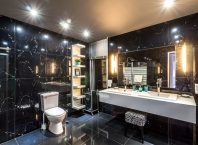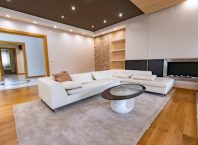Whether your house feels dim, it doesn’t convey the right mood, you want to update its look or save energy, one of the simplest, cheapest and safest ways to do so is by changing the lighting. It is a good way to make it easier to work, entertain, and live in spaces that didn’t feel inviting before. Here are six easy ways to improve lighting inside your house.
Contents [show]
Focus on Your Needs
You don’t want to add a variety of lights to the living room if all you really need is a brighter light for your favorite recliner. If the objective is making a living room brighter, one light stand isn’t going to be good enough. When the goal is directed task lighting, then a directed light beam is what you need, not a bright orb of light. This means that you need to outline what you need, and then select lights that suit that first and foremost.
Get the Right Lights for the Job
If you need more light for specific activities, the best choices are table lamps so you can work at a desk, reading lamps by a chair, or full spectrum lights next to a craft area. Specialized applications may call for less frequent models, such as piano lamps that provide focused downward light at a keyboard or piano.
When you want to improve ambient light or set up discrete accent lights in recessed areas or nooks, then opt for recessed lighting installation and repair instead of trying to put in a network of glowing pendant lights. Work with lighting professionals from Edward’s Enterprises to determine what lights will give you the atmosphere or visibility you want, and always rely on professionals if their installation requires rewiring your home.
When your intent is to create a warm, diffused light, pendant lights and sconces are a better choice than bright overhead lights. If you’ve added a TV or big screen to a room, get rid of some of the overhead light and install ambient lighting and task lighting instead to minimize glare.
Be Strategic with Accent Lights
If your room is entirely lit up with accent lights, something is wrong. Accent lights should be few and far between, only drawing attention to the items you want to be seen. This is why accent lights are commonly built into display cases. If you use that, additional lights are probably unnecessary. Shining accent lights on collectibles and masterpieces is fine, but the lights should be on the few pieces that are the highlights of the collection, not every piece in the collection.
Plan Your Upgrades Based on the ROI
If you don’t know which lights to upgrade first, choose those you’ll use the most. Change out the lightbulbs you leave on the longest with energy efficient LED bulbs to reap the greatest savings. Buy task lights or overhead lights for the areas where you spend the most time. The task light you use five hours a day should be first on the shopping list, not the extra light for the bathroom you only need for ten minutes in the morning. New light bulbs in the dining room chandelier can wait. If you’re going to replace the chandelier anyway, then select one with brighter lights that require less electricity. You can slowly replace older light fixtures in your home and upgrade the lights at that time.
Integrate It Into a Complete System
Look into technological solutions that allow you to connect everything into one home network. Then you can control your old light fixtures via a smart app or home automation system. There are a number of advantages to this. You could turn lights on and off whether you’re at dinner or on vacation, making it appear as if you’re home. This makes it less likely your home will be robbed. You can control your lights from the bed, so you don’t have to go downstairs to turn off a lamp. You could set up energy saving light profiles to turn on lights as the sun goes down but turn them off when not required.
Take the Environment into Account
If you have mirrors on the walls or ceiling, those bright lights will be reflected back through the room and may cause glare. Remember the sunlight streaming into a room. If the room has bright light during the day, select lights you can dim or turn off easily at those times.
Another issue is the color scheme. If a room “feels” dark, maybe you could lighten it by updating the color scheme instead of buying new light fixtures. If it still feels dark despite the lamps you have in the room, opt for thinner, lighter colored shades that produce a bright but diffused light.
Conclusion
Every room needs at least one bright overhead light. What you need beyond that depends on the purpose, décor and regular occupants of that room. We’ve tried to provide tips so you can determine what is best for each room in your home.












